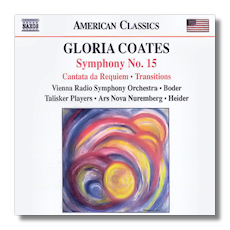
The Internet's Premier Classical Music Source
Related Links
- G. Coates Reviews
- Latest Reviews
- More Reviews
-
By Composer
-
Collections
DVD & Blu-ray
Books
Concert Reviews
Articles/Interviews
Software
Audio
Search Amazon
Recommended Links
Site News
 CD Review
CD Review
Gloria Coates

- Symphony #15 "Homage to Mozart" 1
- Cantata da Requiem "WW II Poems for Peace" 2
- Transitions 3
1 Wiener Rundfunkorchester/Michael Boder
2 Teri Dunn, soprano
2 Talisker Players Toronto
3 Ars Nova Ensemble/Werner Heider
Naxos 8.559371
Although American-born and -educated, composer Gloria Coates has spent much of her career in Germany. Indeed, there's little about her music that sounds American (whatever that is, but we generally know it when we hear it). It is not much of a surprise to learn that her Symphony #1 was a sensation at the 1978 Warsaw Autumn Festival – the same Festival that has showcased the music of Penderecki and other progressive European composers since 1956. As a composer, Coates seems to have more in common with Penderecki and other sonorist composers than with her American contemporaries.
Her Fifteenth Symphony is a very impressive work, but it will not leave listeners feeling very settled. The opening movement, titled "Iridescences," sounds like the cries of a machine that has become trapped in the permafrost. Irresistible forces meet immovable objects, and the result is a sort of harmonic stasis that nevertheless audibly corrodes over the course of the movement. "Puzzle Canon" refers to a theme in Mozart's Ave Verum Corpus which is approximately quoted – first backwards then forwards – during the course of the movement, as the strings engulf it in the sap of Coates's trademark glissandos. "What Are Stars?," a title taken from Emily Dickinson, is built from a meandering brass chorale, threatening timpani, and a chaotic mesh of glissandos. Undoubtedly, Mozart would have been nonplused by this symphony, composed in honor of his 250th birthday, but perhaps he would have been fascinated, as I am, by its daring sounds and its doom-filled atmosphere.
The relatively early (1972) Cantata da Requiem looks at World War II from the viewpoints of women on either side of the conflict – from a young German widow to American poet Marianne Moore. (One of the stopping points in between is a sinister BBC weather report which indicates that "conditions [are] ideal for bombing offensives.") Coates makes no attempt to sentimentalize the thoughts and fears of these women, and the Cantata da Requiem is no less harsh than it needs to be. Again, the instrumental writing is highly imaginative, even descriptive, and the vocal lines, while uncomfortable, match both the words themselves and their intensity.
Transitions (1984), later reworked into Coates's Fourth Symphony (recorded by the CPO label - 999392-2), is a chamber symphony. Coates explains that it is "the translation of metaphysical experiences" she had after the death of her father. The first movement, "Illumination," gradually reveals itself to be built around "Dido's Lament" from Purcell's Dido and Aeneas, although the mournful melody, presented by the piano and trombone, is thwarted by the rest of the ensemble's disruptive grumblings and swoopings. "Mystical Plosives" is rich in percussion, with slow glissandos and tremolos, and culminates in a grotesque dead march. "Dream Sequences" contains layers of slow string glissandos (both ascending and descending), percussion (spasmodic snare drum tattoos prominent), and inscrutable commentaries by winds and trombone. Much of the time, Transitions sounds like middle-period Stravinsky under the influence of heavy hallucinogens. It's far from "pleasant" in the usual sense of the word, but it is never less than interesting, even fascinating.
These are live recordings from three different sources. The symphony was recorded at its final rehearsal in 2006, and the other two works were recorded in concert. Despite the disparity of sources, there are no jarring contrasts among the recordings; the quality of the sound is excellent throughout. As for the performances, they feel committed and confident, and one assumes that they have the composer's approval. Kyle Gann's helpful booklet notes guide the listener with Virgil-like care.
Coates is an important American original who has gone her own way with skill and purpose. Her music will not flatter the ear, but that hardly seems to have been her intention anyway. One admires her for sticking to her vision.
Copyright © 2008 by Raymond Tuttle




















